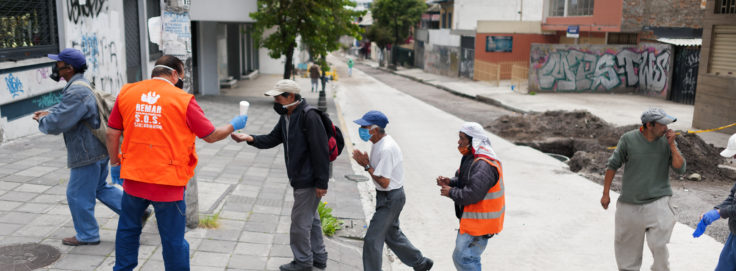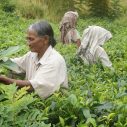
Search
Using Multidimensional Poverty and Vulnerability Indices for Equitable Policy- Making in the Context of Health Emergencies

The World Health Organization (WHO) and the Oxford Poverty and Human Development Initiative (OPHI) have been collaborating to explore how multidimensional poverty and vulnerability indices (MPIs and MVIs) could be, or are already being, used to inform equitable plans, policies, and interventions in the preparedness for, response to, and recovery from, health emergencies. This article summarises some key findings from this collaboration, which prominently drew upon the applications of MPIs and MVIs by several Multidimensional Poverty Peer Network (MPPN) participants during the ongoing COVID-19 pandemic.
Health emergencies threaten lives and livelihoods alike – but they also threaten to hit those already disadvantaged the heaviest. In order to prevent or mitigate their risks and various impacts, policymakers and practitioners require a solid and focused evidence base that identifies those least well-off and most vulnerable to make sure that health emergencies do not exacerbate pre-existing inequalities and deprivations.
In addition to several existing rapid assessment tools and methodologies for emergencies, WHO and OPHI studied how MPIs and MVIs may be able to provide exactly such an evidence-base for the information of well-targeted, equitable policies. By capturing the overlapping deprivations that people experience, MPIs and MVIs identify who is worse off or particularly vulnerable by integrating information on the many dimensions of human development and poverty. In line with the WHO Priority Public Health Conditions Equity Analysis Framework, they can thus help to identify population subgroups that are particularly exposed, susceptible or vulnerable to diseases and the socio-economic implications of health emergencies.
The results of this first study into the uses of MPIs and MVIs in health emergency contexts identified at least four ways in which they have been or could be used to inform equitable health emergency preparedness, response, and recovery. All four of these applications have been implemented by at least one MPPN participant.
Multidimensional Vulnerability Indices
Based on the same method used to build national MPIs (the Alkire-Foster method), several countries constructed multidimensional vulnerability indices (MVIs) whose main objective was to capture overlapping vulnerabilities in the context of COVID-19. Such MVIs helped to identify some of those most vulnerable during the pandemic as well as the main deprivations contributing to their increased multidimensional vulnerability. To highlight just some of the many MVIs that were constructed during the COVID-19 pandemic, consider the cases of Iraq and Honduras, as well as the example for South Africa (see The South African COVID-19 Vulnerability Index (SACVI) in this issue).
In Iraq, the Ministry of Planning devised an MVI in order to produce a rapid assessment of multidimensional vulnerability to risks posed by the COVID-19 pandemic and its socioeconomic implications. Results showed that more than 4 out of 10 Iraqis exceeded a multidimensional vulnerability threshold of experiencing at least one quarter of the weighted vulnerabilities included in the MVI.
MPIs or MVIs can also be directly linked to, or merged with, additionally interesting, aggregate-level data to associate multidimensional measures with other indicators relevant in the context of health emergencies.
In Honduras, the Government, in collaboration with the United Nations Development Programme (UNDP) and OPHI, created an MVI that was directly used to identify and target beneficiaries for the COVID-19 emergency social protection programme Bono Único. Honduras’ COVID-19 MVI included indicators on populations who are vulnerable to disease as well as indicators related to employment, economic resilience, health, food security and housing. The MVI was computed using the National Register of Beneficiaries and additional data from a self-registration platform to ensure that individuals and households not included in the national register were not left out in the selection of beneficiaries. The results of the MVI were then used to distribute food, medicine, and personal protective equipment vouchers worth 2000 Lempiras (circa US$60).
MVIs were also constructed to inform policies during COVID-19 in Bhutan (also one specific to the tourism sector), the Maldives, South Africa and Pakistan.
Re-analysing existing MPIs
Apart from the construction of new measures, such as MVIs, existing measures, too, can and have been used. In many cases, existing MPIs include indicators that can shed light on the (joint) distribution of deprivations that are of particular interest during a health emergency context and can thus help to identify priority subgroups that may require special policy attention. For example, OPHI performed an interlinked analysis of multidimensional poverty and vulnerability to disease using the global MPI. Results showed that 3.6 billion people around the world are affected by undernutrition, lack of a clean source of water, or likely exposure to indoor air pollution. These indicators are all associated with vulnerability to disease and a considerable share of the global disease and mortality burden. At least 435 million people were affected by all three of these factors at the same time, and 336 million of them were multidimensionally poor.
Furthermore, directly linked to the previous exercise, OPHI colleagues also explored deprivations in other contextually relevant indicators, such as, among others, access to internet and domestic violence in South Asia. Across four South Asian countries in the analysis, the percentage of people deprived in additional indicators included was generally higher among the multidimensionally poor. Nepal’s recent 2021 National MPI update, too, presented results based on the same analytical methods, confirming previous findings. A similar exercise was also conducted using El Salvador’s National MPI.
Data Linking and Merging
MPIs or MVIs can also be directly linked to, or merged with, additionally interesting, aggregate level data to associate multidimensional measures with other indicators relevant in the context of health emergencies. The National Statistics Office of Colombia (DANE), for example, merged different data sources to analyse the levels of multidimensional poverty and other relevant indicators during COVID-19 in 2020. Results were integrated into a geoportal that allowed for an integrated analysis of Colombia’s National MPI results, a newly constructed MVI, and additionally relevant health indicators to inform the response to the COVID-19 pandemic and protect the most vulnerable.
Microsimulations
Finally, existing MPIs (or MVIs, for that matter) can be (and have been) analysed using microsimulation techniques. These simulate how people’s vulnerabilities or deprivations might be impacted by shocks, such as those associated with a health emergency, and thus lead to additional deprivations and new or exacerbated multidimensional poverty. During COVID-19 such a microsimulation exercise has been carried out, for example, in Afghanistan by the National Statistics and Information Authority (NSIA) of Afghanistan, the United Nations Children’s Fund (UNICEF) and OPHI. The exercise used data from the Afghanistan Living Conditions Survey (ALCS) 2016/17 and simulated several scenarios of how COVID-19 pandemic-induced shocks might affect MPI indicators and thus overall multidimensional poverty in Afghanistan. The findings showed that, given the scenarios simulated, multidimensional poverty levels based on Afghanistan’s official MPI could increase between as much as 9 and 20 percentage points. Similar exercises have been carried out in the Dominican Republic, Saint Lucia, and Colombia.
An Emerging Field of Study, Exploration, and Application
The usage of MPIs and MVIs for health emergency preparedness, response, and recovery are an emerging field that opens many new questions and possibilities for novel applications. The collaboration between the WHO and OPHI highlighted the flexibility and adaptability of the underlying Alkire-Foster method and the fact that, if data allows, measurement and analysis possibilities go beyond what could be profiled based on existing applications. These areas of particular interest were highlighted:
» Computing MVIs and MPIs using data collected during or immediately after health emergencies;
» Incorporating more health indicators and others relevant in health emergency contexts;
» Linking results and analyses from MPIs and
MVIs with other assessment tools traditionally in health and social humanitarian emergency
contexts.
The hope is that this research brief can inspire inclusive approaches to using Multidimensional measures for equitable public health policies and interventions.
Access here the full WHO Research Brief by OPHI colleagues Jakob Dirksen and Monica Pinilla-Roncancio. Recordings of related webinars can be accessed here for 13 April and here for 24 May, 2021.
This article is available in Dimensions 13
















